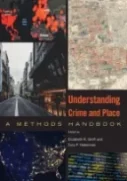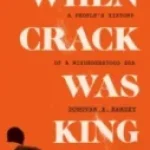Understanding Crime and Place: A Methods Handbook
 Author: Elizabeth R. Groff & Cory P. Haberman (eds.)
Author: Elizabeth R. Groff & Cory P. Haberman (eds.)
Publisher: Temple University Press, 2023. 442 pages.
Reviewer: Shannon Linning | September 2023
Several decades of research in crime at place has uncovered a key lesson for criminology: places matter. But the concept of place for criminology has evolved over time. Traditional spatial criminologists examined crime patterns across neighborhoods. Inspired by the Chicago School from the 1920s onward, they considered factors that impeded residents’ abilities to control crime. These ideas cemented themselves in criminology when Robert Sampson and Byron Groves published the systemic model.[1] The paper showed criminologists how they could use census data to analyze crime patterns at the neighborhood-level. This spawned many neighborhood studies and later collective efficacy theory.[2]
The same year the systemic model was published, however, Lawrence Sherman and his colleagues made a pivotal discovery about places.[3] Their findings showed that, regardless of neighborhood, most addresses experience no crime. Instead, a tiny fraction of addresses had most of the crime. These findings have been replicated in many cities across multiple countries. No study has found an exception. David Weisburd has gone as far as to coin this phenomenon the “law of crime concentration.”[4]
The crime concentration discovery forced criminologists to reconsider what is meant by place and what it means for studying crime patterns. This sparked a debate about whether to study crime at larger areas (e.g., neighborhoods) versus smaller ones (e.g., street segments or addresses). Many books have described the theoretical bases of both perspectives. But to resolve which perspective is most helpful to understanding and preventing crime, we must subject them to empirical testing. Fewer books guide researchers and their students on how to do this.
Editors Elizabeth Groff and Corey Haberman produced a much-needed handbook to assist researchers and their students on this empirical endeavor. Their new book, Understanding Crime and Place: A Methods Handbook, provides short but informative write-ups of the field’s most relevant methods written by 64 experts in the field. Each section is peer-reviewed by at least 3 individuals: another expert, a graduate student, and one of the editors. The book would be useful to those learning spatial analytic methods as well as more experienced researchers who need a refresher about a methodological technique. While the book has a logical flow from cover-to-cover, readers can also keep it in their libraries as a go-to reference guide for specific methods. The digestible sections on each method make for easy, but effective reading.
Groff and Haberman begin the book with brief summaries of the core spatial criminology theories. These are used to refresh a reader’s memory about key principles and questions that could guide their research. The editors also enlisted Ajima Olaghere and John Eck to pen a unique dialogue about incorporating race into crime and place research.
The book then transitions to foundational spatial concepts such as the difference between points versus areal units, the process of geocoding, and various ways to measure distances between points.
Chapter 3 covers the various units of analysis researchers use in crime and place research. These vary on a spectrum from larger units (e.g., neighborhoods) to smaller ones (e.g., street segments). Experts weigh in on the conceptual fuzziness of larger spatial units and use of census tracts as proxies for neighborhoods. Then the editors describe the strengths and weaknesses of using micro-units such as street segments and addresses.
Chapter 4 outlines data sources researchers can seek out to test their questions. Crime data can come from various sources and are typically used as the dependent variable. Additional sources can be used to operationalize independent variables. Researchers also need data, such as street network or census files, to map these data too. The handbook’s sections also deliver information about some of the most widely used sources, including official police report and emergency services data. Other experts weigh in on the use of victimization and self-report data. The final sections describe the land use and crime data as well as how to find and use street network data.
Part 2 of the handbook contains six chapters on research methods and spatial analytic techniques penned by another group of experts who have used or created the methods. These include the Knox test for repeat victimization, Ripley’s K-function and nearest-neighbor analysis for distance-based techniques, Andresen’s spatial point pattern test to see whether there are differences in spatial patterns in two crime incident data sets, and kernel density estimation to product visual displays of crime data. Other chapters inform readers on how to manage spatial autocorrelation and various indices to measure and plot crime concentration. There are also several chapters on regression methods, including nonspatial and spatial linear regression, count regression modeling, geographically weighted regression, and multi-level models.
Readers interested in learning about the stability of crime concentration over time will also find a section on group-based trajectory analysis. The handbook also covers techniques to measure offenders’ journeys to crime and selection of a crime site. The final chapter in this part covers the more recent spatial methods. Examples include conjunctive analysis, agent-based modeling, aoristic crime analysis, and social distance analysis. A strength of part 2 of this book is that most authors explain the data requirements for each technique as well as the strengths and weaknesses of each technique. This feature would make the book an ideal educational resource if instructors wanted to create assignments asking students to determine appropriate methods for a given research question or problem.
Part 3 of the handbook contains three chapters describing how crime and place research can inform policy. Chapter 11 describes how researchers have used randomized controlled trials for place-based research. The authors define key concepts and important considerations such as ways to randomize places, statistical power, treatment fidelity, and how to analyze the data. A common critique of place-based interventions is displacement: crime will move elsewhere. Chapter 12 confronts this critique and outlines the various means of measuring displacement. Chapter 13 concludes the handbook by defining units for place-based research. This includes how to define hotspots for experiments, viewsheds for studies of CCTV effectiveness, and catchment areas for acoustic gunshot detection technology. In the latter two cases, the authors provide step-by-step instructions of how to conduct an analysis.
Finally, one of the best features of the handbook is its supplemental resources. They provide additional bibliographic references for readers wanting to learn more about crime and place. There are also problem sets instructors can assign to students as well as step-by-step examples of how to conduct analyses covered in the handbook. Many of the steps also include color pictures and screenshots guiding readers on how to use the analytic software.
In Supplement 4.3, for example, Kathryn Wuschke provides a 13-page step-by-step explanation of one way a researcher might study how land use influences crime. She leads off with two detailed research questions about the concentration of disorder calls and facilities associated with them. To answer the questions, she shows readers how to acquire free open access data for the city of Washington D.C. She then walks readers through use of ArcGIS to map the datasets and techniques such as spatial join. Readers are then shown how to export the data from ArcGIS and import it into Excel to run descriptive analyses and location quotients. Visual displays, such as screenshots of the software in use, are included throughout.
Other supplemental materials show readers how to use software such as R and python. Supplement 5.3, by Alese Wooditch and Hannah Steinman, for example, provides step-by-step instructions of how to download R and get started with the software. The authors favor use of free open access data so that users can start working on the exercises immediately. Example cities with open data portals they point to include Washington D.C., Houston, Texas, Cincinnati, Ohio, Phoenix, Arizona, and Vancouver, British Columbia
Readers can download the 576-page supplemental materials document from the publisher’s website with a code given upon purchase of the handbook. The open access datasets and step-by-step instructions on how to access all materials to complete the exercises are a major strength of the content. This makes the handbook ideal for instructors teaching crime analysis courses or individuals looking to teach themselves spatial analytic methods or refresh their skills.
Each section of the handbook can guide readers through the communities versus places debate. Researchers must have adequate knowledge of both perspectives to determine which has the most merit. Emerging research in the area is showing the value of understanding crime at the address level and how certain property parcels are networked together to facilitate crime at hotspots (Herold et al., 2020).[5] Future editions of the book could expand upon property ownership and place management and the analytical techniques researchers are using to study them.[6]
Overall, the handbook serves as an excellent primer for anyone interested in crime and place research. It supplies readers with the cutting-edge analytic techniques being used in the field. The book still pays homage to communities and crime research by including sections on larger spatial units such as neighborhoods. Most analytical methods focus on micro-units and some use larger units to provide context, such as in multi-level modeling. In the years ahead, people should come to see the book a foundational given the book can serve researchers, practitioners, instructors, and students.
References
Herold, T.D., Engel, R.S., Corsaro, N., & Clouse, S.L. (2020). Place network investigations in Las Vegas, Nevada: Program review and process evaluations. 1-35. International Association of Chiefs of Police (IACP). https://digitalscholarship.unlv.edu/cj_fac_articles/198
Lee, Y., O, S., & Eck, J. E. (2022). Why Your Bar Has Crime but Not Mine: Resolving the Land Use and Crime – Risky Facility Conflict. Justice Quarterly, 39(5), 1009–1035. https://doi.org/10.1080/07418825.2021.1903068
Sampson, R. J., & Groves, W. B. (1989). Community Structure and Crime: Testing Social-Disorganization Theory. The American Journal of Sociology, 94(4), 774–802. https://doi.org/10.1086/229068
Sampson, R. J., Raudenbush, S. W., & Earls, F. (1997). Neighborhoods and Violent Crime: A Multilevel Study of Collective Efficacy. Science, 277(5328), 918–924. https://doi.org/10.1126/science.277.5328.918
Sherman, L. W., Gartin, P. R., & Buerger, M. E. (1989). Hot spots of predatory crime: Routine activities and the criminology of place. Criminology, 27(1), 27–56. https://doi.org/10.1111/j.1745-9125.1989.tb00862.x
Weisburd, D. (2015). The law of crime concentration and the criminology of place. Criminology, 53(2), 133–157. https://doi.org/10.1111/1745-9125.12070
Shannon J. Linning is an Assistant Professor at the School of Criminology at Simon Fraser University.
[1] Robert J. Sampson & W. Byron Groves, Community Structure and Crime: Testing Social-Disorganization Theory, 94 Am. J. Socio. 774, 774-802 (1989).
[2] Robert J. Sampson et al., Neighborhoods and Violent Crime: A Multilevel Study of Collective Efficacy, Science, Aug. 15, 1997, at 918.
[3] Lawrence W. Sherman et al., Hot spots of predatory crime: Routine activities and the criminology of place, 27 Criminology 27, 27-56 (1989).
[4] David Weisburd, The law of crime concentration and the criminology of place, 52 Criminology 133, 133-157 (2015).
[5] Tamara D. Herold et al., Place network investigations in Las Vegas, Nevada: Program review and process evaluations, International Association of Chiefs of Police (IACP) (2020). https://digitalscholarship.unlv.edu/cj_fac_articles/198
[6] YongJei Lee et al., Why Your Bar Has Crime but Not Mine: Resolving the Land Use and Crime-Risky Facility Conflict, 39 Justice Quarterly 1009, 1009-35 (2022).


